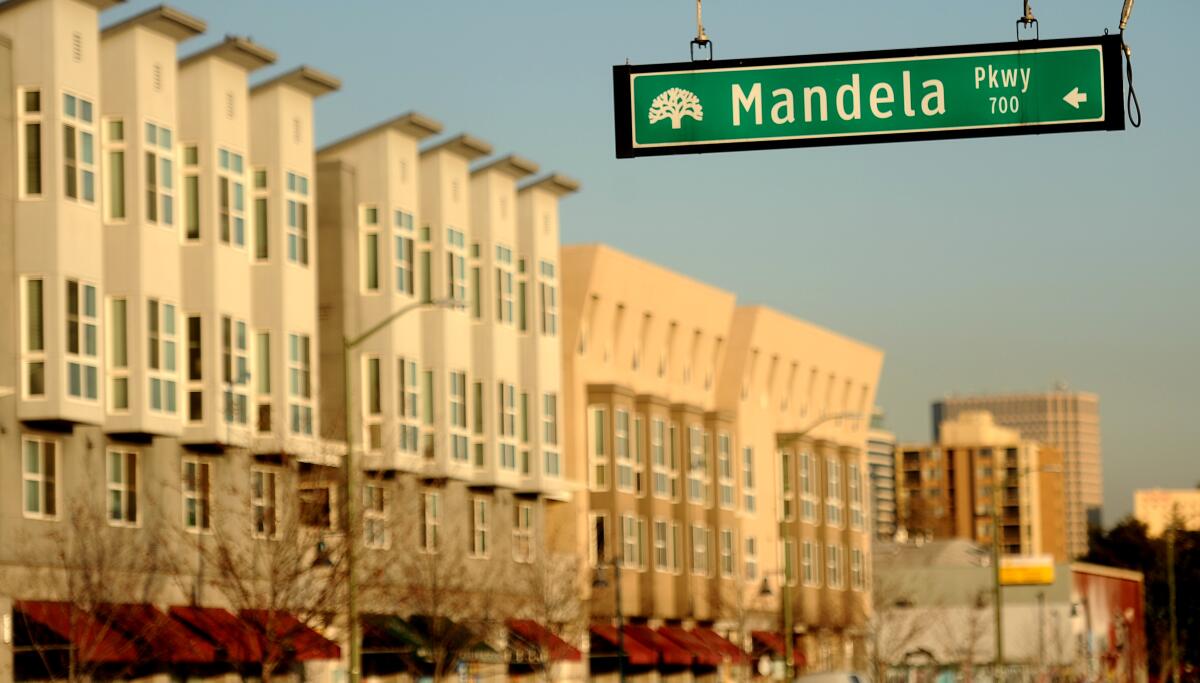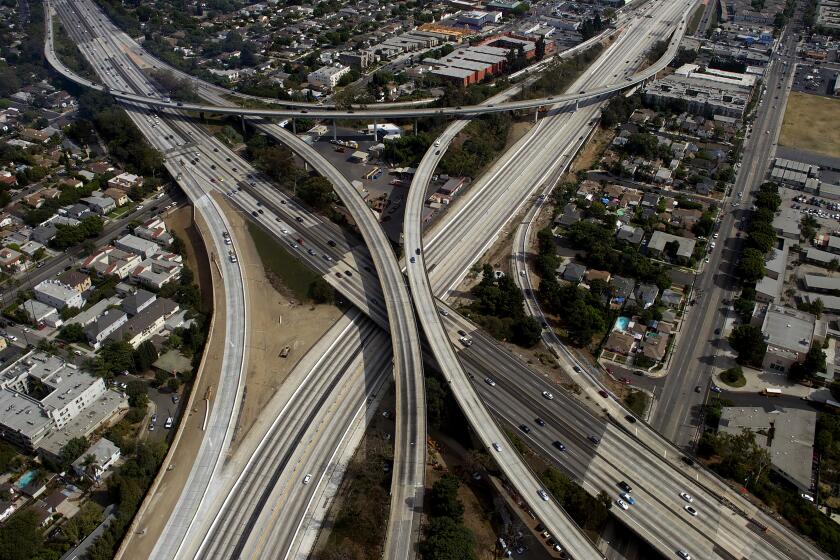Biden has a plan to remove some freeways. Will it make cities more healthy?

- Share via
Mandela Parkway, a four-lane boulevard enhanced by a median with trees and a curving footpath, stretches along a 24-block section of West Oakland. It’s the fruit of a grassroots neighborhood campaign to block reconstruction of an elevated freeway leveled by the Loma Prieta earthquake in 1989 and reimagine the thoroughfare to replace it.
Since the parkway’s 2005 completion, 168 units of affordable housing have sprung up along its route. The air is measurably freer of pollutants than it was when the Cypress Freeway ran through the area.
A federal report heralded the project as the type of socially minded renovation that can make appropriate, if partial, amends for the devastation wrought on low-income neighborhoods by the freeway-building boom of earlier decades.
“Community involvement was a very important part of the rebuilding process,” said the report, which concluded, “West Oakland residents got what they wanted.”
Unfortunately, that’s not entirely the case.
Although the 1.3-mile strip of land that Mandela Parkway passes through has cleaner air and better amenities than when it was a freeway spur, many of the neighborhood’s original residents are no longer there to enjoy it, forced out by rising rents and housing costs. And West Oakland more broadly, bordered by the massive Port of Oakland, is still crisscrossed by elevated freeways where cars and heavy trucks spew hundreds of tons of pollutants every year.
Spewing carbon monoxide across L.A. on the freeway system feeds into a pot of racism and segregation that’s been stewing for nearly a century.
The successes and failures of the Mandela Parkway are emblematic of the challenges faced by a new urban renewal movement, which seeks to replace dozens of stretches of elevated urban freeways built in the 1950s, ’60s and ’70s across the United States. These highways bisected cities, displacing residents and local businesses in what were frequently lower-income, working-class, non-white neighborhoods. Pollution and noise plague the health of those who continued to live nearby.
Today, as many of these roadways near or pass the end of their intended lifespans, policy makers, social justice advocates and urban planners have called for them to come down.
President Biden’s administration agrees. His infrastructure plan calls for highway removal to right historical injustices and improve the health of people who live nearby. At least four bills in Congress would fund such efforts, though none is assured passage.
But the Cypress Freeway conversion shows how complicated it is to accomplish highway removal in a way that improves the health and well-being of the longtime residents wronged by the roadways’ legacy. The effects of neighborhood “greening” can be paradoxical, leading to “green gentrification.”
There’s abundant evidence that living near highways is bad for human health: Research has linked it to higher rates of hypertension, heart attack, neurological illnesses like Alzheimer’s disease and multiple sclerosis, worse birth outcomes and asthma, especially in kids.
But the evidence is shakier on whether transforming the roadways reverses these problems, said Regan Patterson, a transportation equity research fellow for the Congressional Black Caucus Foundation.
A 2019 study conducted by Patterson and Robert Harley of UC Berkeley’s Department of Civil and Environmental Engineering showed that rerouting the Cypress Freeway — Interstate 880 — and building the Mandela Parkway cut nitrogen oxides by an annual average of 38%, and soot by 25%, along the parkway. But West Oakland in general is still heavily polluted by the rerouted I-880, as well as I-580 and I-980.
“You cannot talk about Mandela Parkway if you don’t talk about the impact of all three highways,” said Margaret Gordon, 74, a founding member of the West Oakland Environmental Indicators Project, an environmental justice organization.
And the very upgrade of the area along Mandela Parkway — coupled with the arrival of Big Tech company offices in the area — has contributed to property values spiking and longtime residents leaving. Black residents, who made up 73% of the population around the expressway in 1990, accounted for only 45% in 2010, according to Patterson’s research. Median home values along the parkway jumped by $261,059 in that time frame.
“Green gentrification” is a paradoxical effect of projects intended to support healthier communities, said Jennifer Wolch, a professor of city and regional planning at the UCBerkeley. Her research, focused on the overall public health effects of urban greening, shows that rising housing costs and displacement of longtime residents can also damage their health. Other research has found that residents from marginalized groups reported a lower sense of community after greening transformations.
Longtime Latino residents, for example, reported avoiding segments of Chicago’s 606 pedestrian trail that run through mostly white neighborhoods because of concerns of discrimination. Well-off white residents were more likely than Black residents to use the Atlanta BeltLine, a 33-mile network of trails and parks.
None of these problems seal an argument against highway removal, say urban activists. The Congress for the New Urbanism, a nonprofit focused on sustainable urban development, has identified 15 highways in major U.S. cities that are ripe for removal in its 2021 “Freeways Without Futures” report.
The lesson, instead, is to pay attention to the wishes of longtime community members in planning these infrastructure projects, said Jonathan Fearn, a member of the Oakland Planning Commission and a founder of ConnectOakland, an advocacy group involved in plans to tear down 2-mile-long I-980 and redesign the area.
Twelve years ago, California air quality officials delivered a warning to cities and counties: Avoid putting new homes in high-pollution zones within 500 feet of freeways.
Highway removal and neighborhood renewal should focus on making communities less car-dependent, and adding affordable housing and other amenities, said Dr. Richard Jackson, professor emeritus at the Fielding School of Public Health at UCLA and former director of the CDC’s National Center for Environmental Health.
For example, creating community land trusts — nonprofits that buy vacant lots in communities and sell them back to residents at reduced rates — can help ensure affordable housing and rent stability.
Some of the congressional bills under consideration have provisions that would require anti-displacement strategies. But the $1.2 trillion Bipartisan Infrastructure Framework put forward by the Biden administration, which includes funding for a $1 billion “reconnecting communities” program, offers few details about ameliorating displacement.
If and when the projects get done, conversations about whom they benefit should happen early on, said Ben Crowther, program manager for the Congress for the New Urbanism’s Highways to Boulevards program. But it’s “very encouraging,” he said, that federal bills to fund the remakes include strategies for making sure current residents benefit.
This story was produced by Kaiser Health News, a national newsroom and one of the three major operating programs at the Kaiser Family Foundation.







